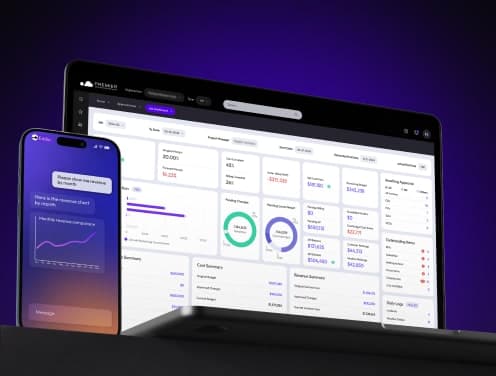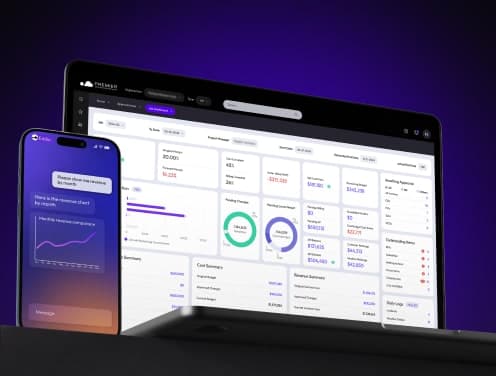
Cloud vs. On-Premises -Which Construction Management Solution Fits Your Needs
The construction industry is evolving rapidly, and the technology used to manage projects can make or break a company’s success. As businesses strive for efficiency, the choice between cloud-based and on-premises construction management solutions is becoming a critical decision. Each approach offers unique advantages and challenges that can significantly impact project outcomes.
Cloud construction management solutions have surged in popularity, providing flexibility, remote access, and scalable resources that adapt to the fast-paced nature of construction. On the other hand, on-premises solutions allow for greater customization and control, appealing to organizations prioritizing security and specific operational needs. Understanding these differences is essential for making an informed decision.
This article will delve into the pros and cons of cloud and on-premises construction management solutions. By comparing key features, costs, security measures, and future scalability, you’ll be equipped to choose the best solution tailored to your organization’s requirements.
Cloud Construction Management Solutions
Cloud construction management solutions are revolutionizing how teams handle projects. With unparalleled accessibility, they enable geographically dispersed teams to access vital project data from any location with an internet connection. This capability helps eliminate data silos, fostering collaborative workflows throughout the design and construction lifecycle. The increasing trend toward cloud adoption is evident as Gartner, Inc. predicts spending on public cloud services in construction to soar by 20.7% to $591.8 billion in 2023. The cloud environment allows companies to build a comprehensive tech stack, integrating various software applications to modernize operations, save time, and boost profitability.
Overview of Cloud Solutions
Cloud solutions offer seamless automatic updates and enhanced collaboration, reducing manual maintenance and minimizing downtime. Because resources are accessible from anywhere with internet connectivity, these solutions provide agility and scalability, crucial for dynamic business needs. Their subscription-based pricing model reduces upfront costs, offering a predictable expense structure that is financially attractive to businesses. Quick deployment without lengthy installation processes allows companies to start using applications almost immediately. Managed services from cloud providers free companies from maintaining IT infrastructure, reducing operational costs.
Key Features of Cloud Software
Cloud software offers built-in remote access, allowing users to log in from any web-enabled device, enhancing flexibility for teams in the field or away from the office. These solutions generally have low upfront costs and can rapidly deliver ROI through time savings and improved process efficiency compared to traditional on-premise systems. They can easily scale computing resources up or down, eliminating additional hardware investments for growing projects. Advanced security measures, such as data encryption and automated backups, protect sensitive information without significant organizational effort. Real-time communication and updates enable seamless collaboration among team members, ensuring alignment regardless of location.
Benefits of Remote Access
Cloud-based solutions deliver unparalleled accessibility, empowering teams to access and manage project data from anywhere, benefiting geographically dispersed construction teams. Enhanced performance in cloud services ensures that remote access maintains the efficiency of data-intensive tasks. Real-time collaboration through cloud systems enables remote teams to manage files efficiently, leading to more effective construction project management. By outsourcing IT infrastructure to cloud providers, companies alleviate in-house IT burdens, focusing instead on core business activities. Businesses also benefit from superior disaster recovery capabilities, ensuring secure data access even during unforeseen events.
Scalability and Flexibility
On-premises software struggles with scalability due to the need for manual installations by IT staff to accommodate more users. In contrast, cloud solutions scale effortlessly, adapting to business growth without significant infrastructure investment. Hybrid cloud systems combine on-premises and cloud-based features, offering scalable solutions based on implementation. While private cloud solutions provide some cloud benefits like scalability and flexibility, they are still managed by an internal IT department. Cloud construction management solutions efficiently adapt to growing project demands by allowing quick scalability and flexibility.
On-Premises Construction Management Solutions
On-premises construction management solutions involve hosting software and data on a company’s internal infrastructure. These versatile solutions effectively handle intricate project workflows, catering to the unique needs of construction projects. Selecting the right on-premises system is vital for adhering to project timelines, budget constraints, and quality requirements. Partnering with experienced providers is essential to successfully implement these systems in alignment with the company’s IT strategy. On-premises solutions can offer superior security, assuming organizations are capable of maintaining robust infrastructure.
Overview of On-Premises Solutions
On-premises solutions demand companies purchase and maintain their IT infrastructure, including servers, storage, and licenses. This setup affords businesses complete control and customization over their IT environment, harmonizing with specific operational needs. Enhanced security and compliance measures are often more effectively managed, benefiting those with sensitive data. Proximity to IT resources eliminates reliance on internet connectivity and ensures uninterrupted access. However, this comes with high initial costs and ongoing maintenance commitments.
Key Features of On-Premises Software
On-premises software offers unmatched control and customization, enabling businesses to tailor IT environments to meet precise needs. Enhanced security and compliance are significant advantages, with direct oversight of sensitive data aiding in regulatory compliance. Unlike cloud-based services, these systems do not depend on internet access, ensuring continuity during connectivity issues. Storing data locally also enables faster processing, a critical feature for handling vast project data efficiently. The flexibility to create tailored security protocols further enhances its appeal.
Benefits of Customization and Control
On-premises deployments empower organizations with extensive control and customizability, aligning with unique business objectives. This flexibility allows for niche customization, essential for meeting specialized operational demands. On-premises users can implement and manage their own security measures, oftentimes perceiving them as more secure than those offered by cloud alternatives. Although initially requiring substantial investments in hardware and IT expertise, these solutions offer enduring control and adaptability through the lifecycle of the platform.
Enhanced Security Considerations
While cloud providers are investing significantly in cutting-edge security technologies, including advanced encryption, on-premises solutions require organizations to oversee their own security. This self-management can present vulnerabilities if not maintained diligently, contrasting with cloud providers’ dedicated security teams. Cloud hosting excels with built-in redundancy and disaster recovery, reducing risks tied to hardware failure. Many top construction ERP partners leverage top cloud providers to bolster security without the maintenance burden of on-premises infrastructure, yet control remains a valued aspect of premises solutions.
Comparing Costs: Cloud vs. On-Premises

Choosing between cloud-based and on-premises construction management solutions involves understanding the key cost differences. On-premises solutions demand significant upfront investments and capital expenditures for hardware, software licenses, and IT infrastructure. In contrast, cloud solutions minimize initial investments through a subscription model, turning costs into more manageable operating expenses. Carefully evaluating these financial aspects is essential for making an informed decision.
Initial Investment and Licensing Fees
On-premises solutions require substantial upfront costs for software licenses, hardware, and necessary infrastructure such as servers and backup systems. This capital expenditure can strain financial resources, especially for small to medium-sized enterprises. Conversely, cloud-based solutions involve lower initial costs, often structured as monthly or yearly subscriptions, which can be more accommodating for businesses with limited capital.
Maintenance and Operational Costs
Maintaining on-premise systems involves ongoing expenses for hardware repairs, software updates, and security measures, requiring dedicated staff and resources. This adds significantly to the total cost of ownership and can burden a company’s budget. Scaling these systems also requires additional hardware and software investments. Cloud-based services alleviate these concerns by bundling updates and maintenance into the subscription fees managed by cloud service providers.
Long-term Financial Implications
While cloud solutions may appear more cost-effective initially, their subscription models can lead to higher costs over the long term than owning on-premise systems outright. On the flip side, cloud systems typically offer better ROI when considering not just initial costs but also long-term operational and maintenance expenses. Nonetheless, data sovereignty issues linked to cloud storage could introduce additional compliance costs. Each option has distinct financial implications that need careful evaluation based on the specific needs and constraints of a construction project.
Deployment Methodologies: Cloud vs. On-Premises
Choosing between cloud and on-premises deployment is crucial for any construction management solution. On-premises software is hosted on the company’s hardware, offering complete control over data and security. Conversely, cloud-based software is housed on the providers’ remote servers, accessed via a web browser. Cloud deployment offers a faster and more flexible setup, while on-premises solutions provide security and customization advantages, albeit with higher upfront costs.
Installation Timeframes and Requirements
Cloud-based solutions can be deployed rapidly, often within minutes, allowing teams to start immediately. This contrasts with on-premises systems, which require significant initial setup time and capital investment in hardware and infrastructure. On-premises deployment also demands technical expertise for installation and maintenance, potentially incurring additional costs and delaying the start of operations.
User Training and Support Needs
Construction management software should come with robust support and training resources to ease the transition and enhance usability. Cloud-based systems often feature intuitive interfaces that require guidance on accessibility features. On-premise solutions may involve more complex training due to bespoke customizations. Scalability and ongoing vendor support play crucial roles in minimizing the learning curve and keeping users updated with new features.
Integration with Existing Systems
Effective integration of project management software with existing systems like CRM and accounting tools is essential for streamlined workflows. Cloud-based software offers easy connectivity with various applications, facilitating cohesive data management. While on-premise solutions may allow for greater customization, they often require more effort to integrate. Organizations should evaluate their integration needs to ensure that the chosen deployment method aligns seamlessly with current systems, enhancing both efficiency and accuracy.
Security Measures: Cloud vs. On-Premises

Cloud security has significantly advanced, with providers investing heavily in robust measures such as cloud data backup and Cloud Workload Protection Platforms (CWPP). These enhancements make cloud environments increasingly safer compared to on-premises systems. On-premises solutions, however, demand that organizations manage their own hardware and security processes, often falling short of the comprehensive capabilities offered by dedicated cloud providers. Implementing off-site backup is crucial for on-premises storage to mitigate the risk of data loss.
Data Protection Strategies
Cloud service providers deploy advanced encryption protocols and multi-factor authentication to secure data both in transit and at rest. Despite common concerns about cloud security, providers typically invest heavily in infrastructure protection, using dedicated teams to shield data centers from cyber threats. On-premises solutions allow companies to customize security based on their needs but also require internal IT teams to handle the complexities of security management. Notably, cloud solutions come with built-in redundancy and disaster recovery, providing superior data protection against hardware failures and natural disasters.
Compliance with Regulations
For construction companies dealing with sensitive data and stringent compliance mandates, on-premise solutions may be preferable due to complete control over data and security measures. This control is vital for adhering to privacy and security regulations. In contrast, cloud providers invest heavily in security, but some firms with strict requirements may still opt for on-premises to ensure compliance. On-premises systems, however, involve significant internal responsibility for data management, particularly when employing private cloud environments.
Security Risks and Mitigations
The principal risk of cloud computing lies in data breaches from potential vulnerabilities within cloud systems. Companies must actively manage their cloud attack surfaces by discovering and cataloging assets, identifying misconfigurations, and addressing vulnerabilities. It is essential for enterprises to ensure that third-party cloud providers comply with industry-specific regulatory standards, particularly when handling sensitive information. While on-premises solutions offer control over security protocols, cloud solutions frequently provide advanced measures that are challenging for individual organizations to implement on their own.
Future Scalability: Cloud vs. On-Premises
Cloud-based solutions offer unparalleled flexibility for scalability. Users can easily scale services up or down with minimal effort, which is ideal for adapting to fluctuating demands. In contrast, scaling an on-premise solution often entails purchasing additional hardware or software licenses, making it both time-consuming and expensive.
On-premise systems face significant scalability challenges that require manual intervention from IT staff. This makes deploying additional users or resources cumbersome and inefficient. For organizations aiming for agility, cloud solutions are better suited as they avoid the long-term commitments associated with premises software.
Growth Potential and Adaptability
Cloud-based software excels in adaptability, allowing operations to scale without major extra expenses. This makes it an excellent choice for organizations expecting rapid growth. Cloud systems also eliminate the need for substantial upfront investments in IT infrastructure, enabling businesses to adjust usage and costs according to current needs.
Cloud computing offers nearly instant provisioning capabilities. Applications are ready for use immediately upon subscription, supporting quicker responses to evolving project demands. The collaborative nature of cloud environments enhances adaptability across team operations, fostering dynamic growth.
Upgrading and Maintenance Processes
Cloud solutions streamline the upgrading process by automatically installing updates when available. This eliminates the wait times and manual efforts often required for on-premise solutions. On-premise systems need an in-house IT team for such tasks, increasing resource demands.
Cloud-based environments facilitate faster deployment of software and applications due to available hosting infrastructure. They centralize IT support, reducing the burden on a company’s internal resources. Businesses utilizing cloud services benefit from predictable operational expenses rather than the high upfront costs linked to ongoing premises software maintenance.
Long-term Viability for Project Needs
The choice between cloud-based and on-premise solutions affects an organization’s long-term viability. Cloud environments typically offer enhanced scalability and flexibility, advantageous for adapting to evolving project demands. However, organizations handling highly sensitive data might prefer on-premise solutions for their greater control and security.
Collaboration needs in construction projects may lean towards cloud solutions. They facilitate real-time communication and accessibility, important for teams spread across locations. Ultimately, a well-chosen construction management system, whether on-premise or cloud-based, can efficiently support day-to-day operations and prepare organizations for future challenges.
Conclusion: Choosing the Right Solution for Your Needs
Selecting between cloud and on-premise construction management solutions is crucial for optimizing project outcomes. Cloud-based options provide flexibility and are ideal for teams needing remote access. On-premise software offers control and reliability, beneficial for organizations with existing infrastructure and resources. Fast deployment is a hallmark of cloud solutions, whereas on-premise systems might entail a lengthy setup.
Key Considerations for Decision Making
When choosing a solution, consider project requirements, collaboration needs, and budget constraints. Cloud computing offers accessibility, scalability, and automatic updates, reducing IT burdens. Conversely, on-premise solutions ensure complete customization and data control, vital for some enterprises. Evaluate your current IT setup and weigh cloud integration against legacy reliability and security.
Aligning Solutions with Organizational Goals
Cloud-based software specializes in real-time data insights, pivotal for aligning projects with strategic objectives. These solutions scale easily, adapting to evolving organizational goals. Centralized access enhances collaboration and efficiency. Choosing a competent cloud provider minimizes IT concerns, allowing the focus to stay on achieving core business aspirations.





















